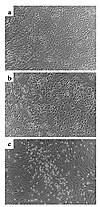Submit a comment
Citation Information: J Clin Invest. 2001;107(3):305-315. https://doi.org/10.1172/JCI11092.
Abstract
B-cell accumulation and formation of ectopic germinal centers are characteristic changes in the diseased joints of patients with rheumatoid arthritis (RA). Earlier studies suggested that interactions between B lymphocytes and specialized synovial “nurse-like” cells peculiar to the RA synovium may be responsible for the homing and sustained survival of B cells in the synovium. However, in this study, we found that B cells spontaneously migrate beneath ordinary fibroblast-like synoviocytes (FLSs) and then experience prolonged survival. FLSs isolated from joints of patients with osteoarthritis also supported this activity, termed B-cell pseudoemperipolesis. We found that FLSs constitutively expressed the chemokine stromal cell–derived factor-1 (SDF-1), and that pertussis toxin or antibodies to the SDF-1 receptor (CXCR4) could inhibit B-cell pseudoemperipolesis. However, expression of SDF-1 is not sufficient, as dermal fibroblasts also expressed this chemokine but were unable to support B-cell pseudoemperipolesis unless previously stimulated with IL-4 to express CD106 (VCAM-1), a ligand for the α4β1 integrin, very-late-antigen-4 (VLA-4 or CD49d). Furthermore, mAb’s specific for CD49d and CD106, or the synthetic CS1 fibronectin peptide, could inhibit B-cell pseudoemperipolesis. We conclude that ordinary FLSs can support B-cell pseudoemperipolesis via a mechanism dependent upon fibroblast expression of SDF-1 and CD106.
Authors
Jan A. Burger, Nathan J. Zvaifler, Nobuhiro Tsukada, Gary S. Firestein, Thomas J. Kipps
Guidelines
The Editorial Board will only consider comments that are deemed relevant and of interest to readers. The Journal will not post data that have not been subjected to peer review; or a comment that is essentially a reiteration of another comment.
- Comments appear on the Journal’s website and are linked from the original article’s web page.
- Authors are notified by email if their comments are posted.
- The Journal reserves the right to edit comments for length and clarity.
- No appeals will be considered.
- Comments are not indexed in PubMed.
Specific requirements
- Maximum length, 400 words
- Entered as plain text or HTML
- Author’s name and email address, to be posted with the comment
- Declaration of all potential conflicts of interest (even if these are not ultimately posted); see the Journal’s conflict-of-interest policy
- Comments may not include figures



Copyright © 2025 American Society for Clinical Investigation
ISSN: 0021-9738 (print), 1558-8238 (online)

